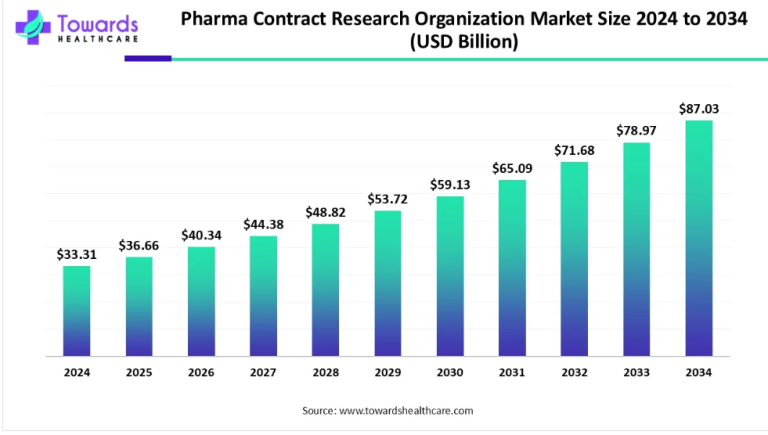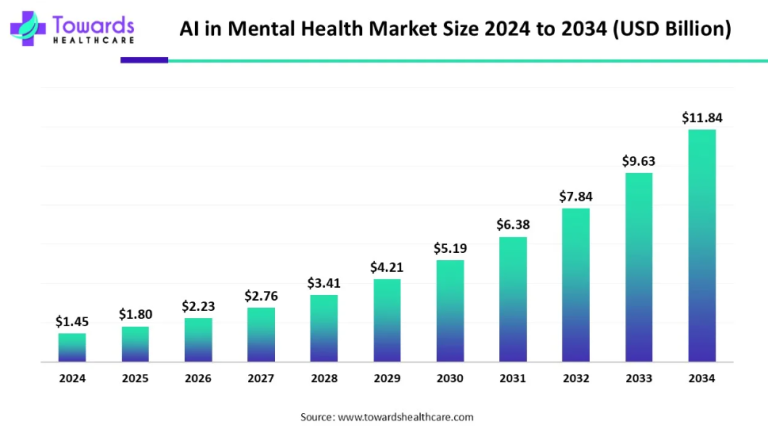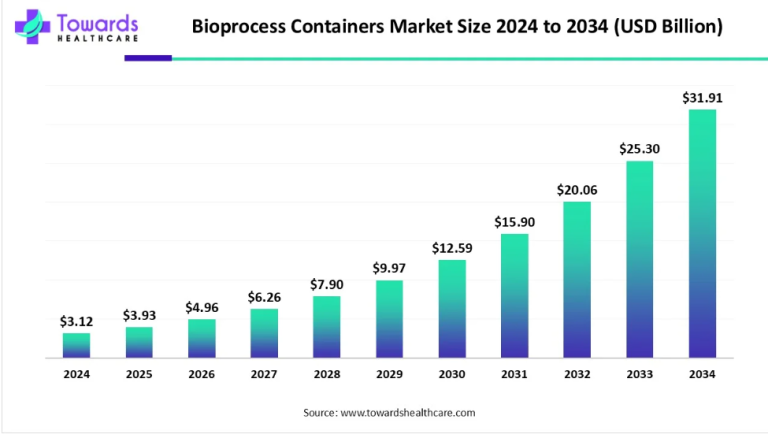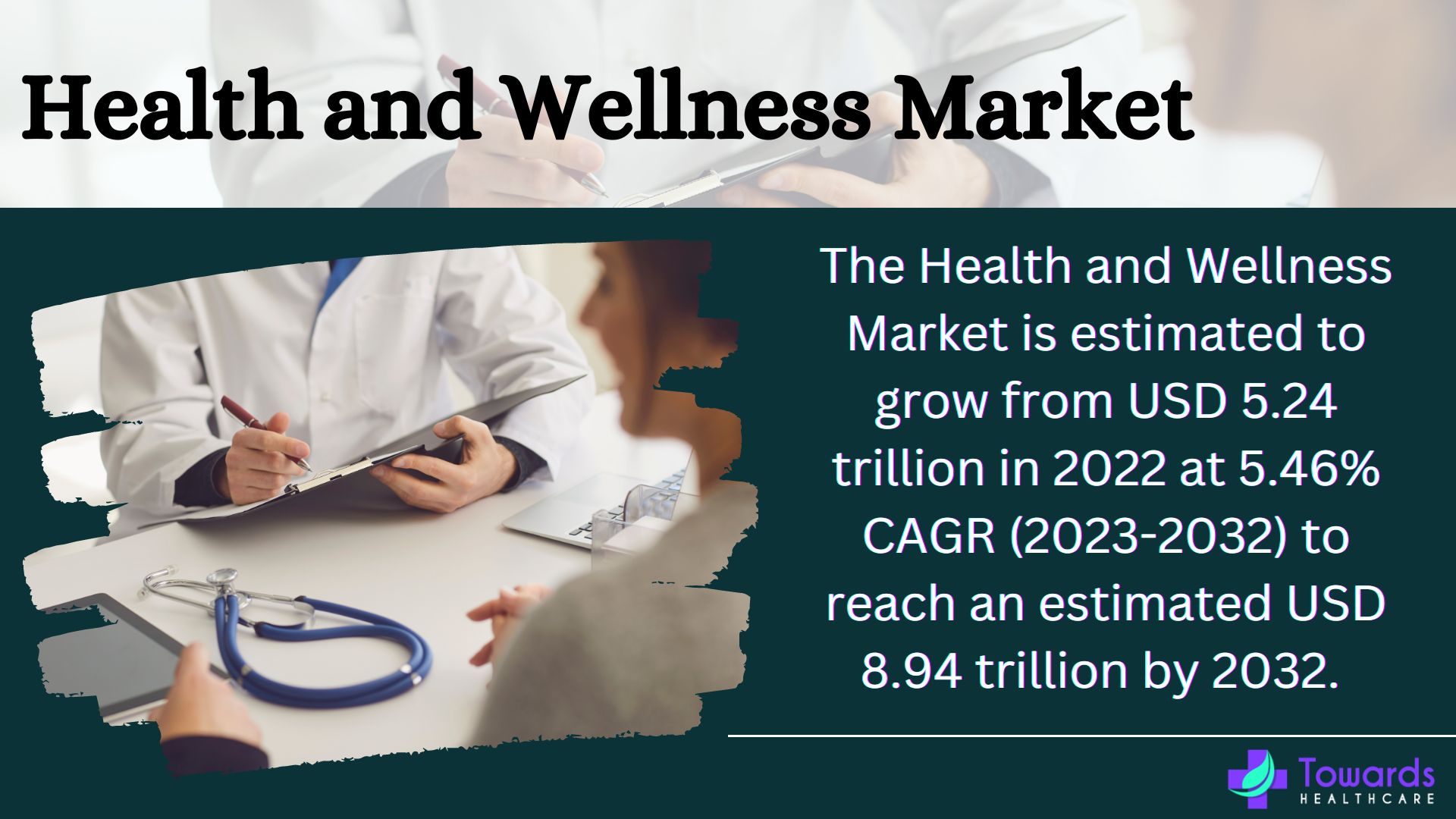
In the ever-expanding domain of health and wellness market, is poised for substantial growth. With an estimated value of USD 5.24 trillion in 2022, the market is forecasted to exhibit a steady 5.46% compound annual growth rate (CAGR) from 2023 to 2032. By the culmination of this transformative period, the health and wellness market is projected to ascend to an impressive USD 8.94 trillion.
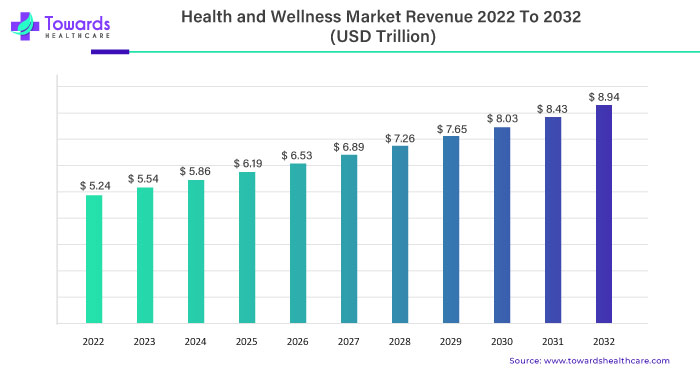
The Pillars of Growth
Holistic Wellbeing: A Prevailing Trend
At the core of the remarkable expansion of the health and wellness market lies the pervasive emphasis on holistic wellbeing. Consumers are increasingly prioritizing physical, mental, and emotional health, driving the demand for a diverse array of products and services that cater to comprehensive wellness.
Lifestyle Choices and Preventive Healthcare
The shift towards preventive healthcare and conscious lifestyle choices is contributing significantly to the market’s ascent. Consumers are proactively seeking solutions that promote longevity and vitality, fostering a cultural shift towards a proactive approach to health.
As Consumer Interest and Purchasing Power Continue to increase, the Healthcare and Wellness Market Widens Growth Opportunities
The health and wellness market is a broad industry that encompasses a range of products and services aimed at promoting physical, mental, and emotional well-being. This includes fitness and nutrition products, personal care and beauty items, natural and alternative medicine, spa and relaxation services, and more. One of the key driving factors for the health and wellness market is the growing interest in preventative healthcare, as people seek ways to maintain good health and avoid illness. The rise of chronic diseases, such as diabetes, heart disease, and obesity, has also led to increased awareness about the importance of healthy lifestyle choices.
In addition, the aging population and the growing interest in healthy aging have driven demand for products and services that address age-related concerns and promote healthy aging. The rise of technology, including wearables and other fitness-tracking devices, has also played a significant role in the growth of the health and wellness market, providing consumers with new ways to monitor and manage their health.
Asia Pacific Takes the Lead: Health and Wellness Market Set for Rapid Growth
The health and wellness market is set for rapid growth, with Asia Pacific leading the way. The increasing prevalence of chronic diseases, rising healthcare costs, and growing awareness of the importance of a healthy lifestyle are driving demand for health and wellness market products and services.
Asia Pacific is expected to see the fastest growth in the health and wellness market, with countries like China and India experiencing particularly strong growth. This can be attributed to factors such as a rapidly growing middle class, increasing urbanization, and rising disposable incomes.
Asia Pacific was the highest contributor to this market, with a 30.95% revenue share in 2022, and is anticipated to reach 31.26% revenue share by 2032, registering a CAGR of 5.0% (2023-2032).
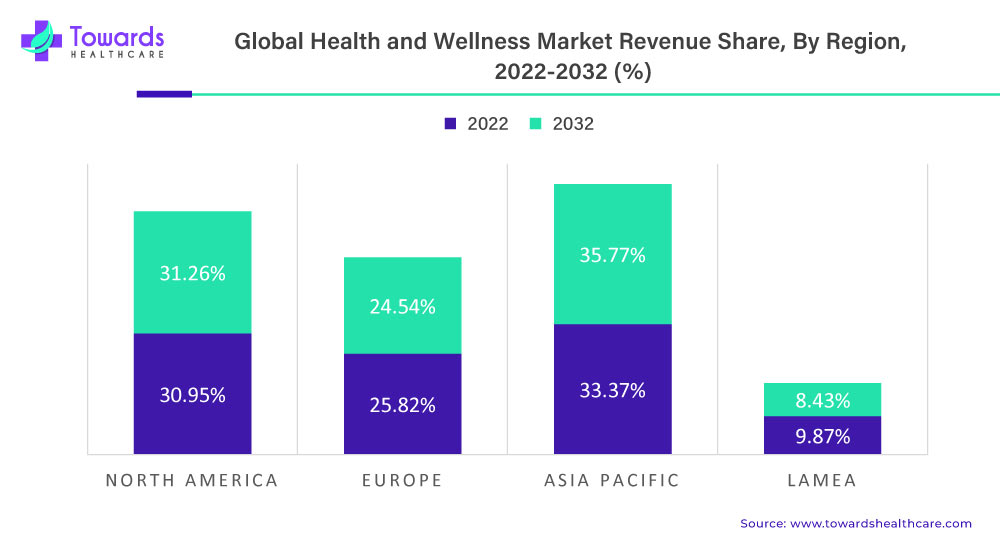
In addition to traditional health and wellness market products like supplements and vitamins, there is also a growing demand for natural and organic products, as consumers become more concerned about the quality and safety of the products they use.
The rise of e-commerce platforms is also making health and wellness products more accessible to consumers, especially in regions with limited access to traditional brick-and-mortar stores. Furthermore, the COVID-19 pandemic has accelerated the adoption of e-commerce, as consumers increasingly turn to online channels for their shopping needs.
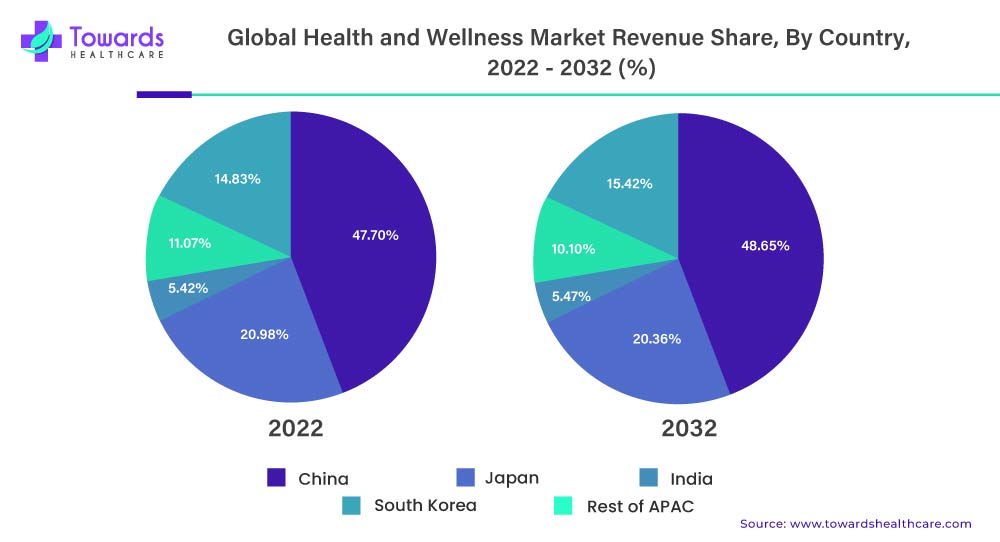
The growth of China’s cosmetics market is being driven by several factors, including an increase in demand for premium products and the rise of working women. In addition, the trend of purchasing personal care and cosmetic products online is contributing to the market’s expansion. According to the International Trade Administration, China’s retail sales of cosmetics reached $52.3 billion in 2020, making it the world’s second-largest market for beauty and personal care products after the United States. Thus, the health and wellness market is expected to continue to grow rapidly in the coming years, with Asia Pacific at the forefront of this growth.
On the other hand, the moderate growth in the global health and wellness market is mainly attributed to North America, where there has been an overall increase in health and wellness expenditure. According to the Centers for Medicare and Medicaid Services, the spending on health care in the United States rose by 9.7% in 2020 to $4.1 trillion, equivalent to $12,530 per person.
The health and wellness market in Europe is also experiencing significant growth, driven by several factors such as increasing consumer awareness about the benefits of a healthy lifestyle, rising demand for natural and organic products, and an aging population seeking to maintain their health and prevent age-related diseases. In addition, the European Union has implemented several initiatives and regulations aimed at promoting a healthy lifestyle and preventing chronic diseases, which are expected to drive the growth of the health and wellness market in the region. Thus, the health and wellness market in Europe is expected to continue to grow in the coming years.
Timeless Beauty: The Overwhelming Influence of Personal Care and Aging on Health and Wellness Market
Personal care, beauty, and aging play a significant role in the health and wellness market. As people age, their healthcare needs change, and they become more interested in products and services that promote healthy aging, including maintaining their appearance and self-care routines.
The beauty industry is an important segment of the health and wellness market, as it encompasses a wide range of products and services that promote physical appearance and mental well-being. The beauty market includes skincare, makeup, haircare, and fragrance products, among others. Consumers are increasingly seeking products that not only make them look good but also provide health benefits. For example, skincare products that contain natural ingredients, vitamins, and antioxidants are becoming increasingly popular as people seek to improve the health and appearance of their skin. Additionally, the beauty industry is responding to the growing demand for sustainable and eco-friendly products, with many brands incorporating eco-friendly practices into their production processes and packaging.
The personal care industry is particularly significant in this regard, with consumers seeking products that help them look and feel their best. This includes skincare, haircare, and cosmetics products that address specific concerns related to aging, such as wrinkles, fine lines, and age spots.
Furthermore, the aging population is driving demand for products and services that promote overall health and well-being, including exercise equipment, healthy food options, and supplements. The rise of alternative medicine, such as traditional Chinese medicine and Ayurveda, is also a response to this trend, as people seek natural and holistic approaches to healthcare.
As of 2022, the personal care, beauty, and anti-aging sectors were the highest contributor to this market, with a 21.51% revenue share, and is anticipated to exhibit a 22.37% revenue share by 2032, registering a CAGR of 5.9% (2023 to 2032). While the nutrition & weight loss services segment is projected to witness the fastest growth with a CAGR of 6.2% (2023-2032).
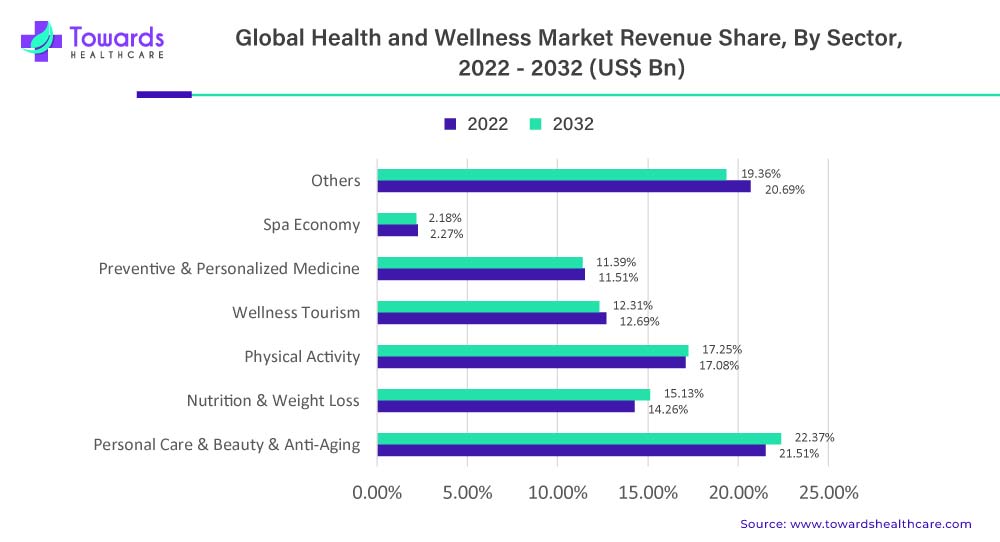
Furthermore, healthcare costs are rising globally, making it more important than ever for individuals to take responsibility for their own health and well-being. This includes seeking out products and services that promote healthy living, such as fitness classes, healthy food options, and natural supplements.
Moreover, the growing interest in preventive healthcare is also driving growth in the health and wellness market, as people seek to prevent disease before it occurs. This includes regular check-ups, health screenings, and lifestyle changes to reduce the risk of chronic diseases.
Thus, personal care and aging are two major factors influencing the health and wellness market, with consumers seeking products and services that help them look and feel their best as they age. As the global population continues to age, this trend is expected to continue driving growth in the health and wellness market.
The Rise of High-Performance Skincare Ingredients and Anti-Aging Tools
The beauty industry is constantly evolving, and one of the current trends is the rise of high-performance skincare ingredients and anti-aging tools. Consumers are increasingly seeking products that not only offer immediate results but also long-term benefits for their skin.
In today’s market, consumers seek skincare products that provide visible and long-lasting effects. The efficacy and quantity of ingredients used in a product elevate its cosmetics status. Cosmeceuticals are cosmetics that contain bioactive compounds marketed for their medical benefits. This term combines “cosmetics” with “pharmaceuticals.” Cosmeceuticals include an essential skincare product that contains a physiologically active ingredient with a medicinal effect on the skin. By influencing the skin’s structure and function, high-performance extracts and ingredients can enhance the skin’s appearance.
Some of the most popular high-performance skincare ingredients include retinoids, vitamin C, hyaluronic acid, and peptides. These ingredients have been shown to improve skin texture, reduce the appearance of fine lines and wrinkles, and even out skin tone. They are often included in serums, creams, and masks that target specific skin concerns.
In addition to ingredients, anti-aging tools have become increasingly popular in the beauty industry. These include facial rollers, LED light therapy devices, and microcurrent devices. These tools are designed to stimulate collagen production, reduce inflammation, and promote cell turnover, resulting in a brighter, more youthful-looking complexion.
Thus, the rise of high-performance skincare ingredients and anti-aging tools reflects the growing demand for products that not only improve the appearance of the skin but also provide long-term benefits. As the beauty industry continues to innovate, it is likely that we will see even more advanced skincare ingredients and tools in the future.
From Sweat to Success: The Rise of Fitness as a Lucrative Industry
The fitness industry has experienced rapid growth in recent years, becoming a highly lucrative market. This growth can be attributed to several factors, including an increased focus on health and wellness market, the rise of social media and influencer marketing, and the popularity of high-intensity workouts and boutique fitness studios. Consumers are becoming more health-conscious and are prioritizing fitness as a way to maintain overall well-being. This trend is reflected in the increasing number of gym memberships and fitness class enrolments, as well as the popularity of wearable fitness technology.
In addition, social media and influencer marketing have also played a significant role in the growth of the fitness industry. Influencers and fitness celebrities promote a certain lifestyle and aesthetic, which often includes a focus on fitness and health. This has led to the rise of fitness communities and increased demand for fitness-related products and services. The popularity of high-intensity workouts and boutique fitness studios has driven innovation in the industry, with the introduction of new classes and equipment. The rise of virtual fitness classes and at-home workout programs has also made fitness more accessible and convenient for consumers.
Furthermore, wearable technology is one of the major driving forces behind the growth of the health and wellness market, particularly in the fitness sector. Wearables, such as fitness trackers and smartwatches, provide users with real-time feedback on their physical activity, heart rate, and sleep patterns, among other things. This data can help users set and achieve fitness goals, track progress, and make adjustments to their workout routines. The rise of wearable technology has also led to the development of more advanced fitness and health apps, which can be accessed through these devices. These apps provide users with personalized workout plans, nutrition advice, and even mental health support.
Moreover, wearables have made fitness more accessible to a wider audience, including those who may not have been interested in traditional gym-based workouts. With the ability to track progress and receive feedback in real time, wearables can motivate users to be more active and adopt healthier lifestyles. Thus, the fitness industry is set to continue its rapid growth as consumers prioritize health and wellness market and seek out new ways to stay active and engaged in their fitness journey.
Relaxation Renaissance: The Growing Demand for Thermal and Mineral Springs and Spas
As people become increasingly aware of the importance of self-care and relaxation for their overall health and well-being, the demand for thermal and mineral springs and spas is on the rise. Thermal and mineral springs are natural sources of mineral-rich water that have been used for therapeutic purposes for centuries, while spas offer a range of services, including massages, facials, and other treatments designed to promote relaxation and rejuvenation.
In recent years, the popularity of these types of experiences has grown significantly, with more people seeking out spas and thermal and mineral springs as a way to de-stress and improve their physical and mental health. This trend is driven in part by the growing awareness of the negative effects of stress on health, as well as the increasing interest in alternative and holistic approaches to healthcare.
Furthermore, the rise of wellness tourism has contributed to the growth of the thermal and mineral springs and spa industry. Many travelers now seek out destinations that offer relaxation and wellness experiences, including thermal and mineral springs and spas. This trend is expected to continue as more people prioritize self-care and seek out experiences that promote their overall well-being.
Hence, the growing demand for thermal and mineral springs and spas is a reflection of the increasing importance of relaxation and self-care in the health and wellness industry. As this trend continues, it is expected to drive growth in the market for these types of experiences.
The Chronic Disease Epidemic: A Growing Threat to Global Health, Creating Growth Opportunities
The chronic disease epidemic is a significant driver of the health and wellness market, as consumers increasingly seek products and services to prevent and manage chronic conditions. Chronic diseases, such as diabetes, heart disease, and cancer, are the leading cause of death worldwide and are associated with a range of risk factors, including poor diet, physical inactivity, and stress.
Regular physical activity can have numerous benefits for our overall health, physical fitness, and quality of life. It can lower the risk of developing chronic illnesses such as type 2 diabetes, cardiovascular disease, several cancers, stress, anxiety, and Alzheimer’s. Aerobic exercise can help with weight loss and improve heart and endurance. High-intensity cardiovascular exercise is generally safe and effective for most people, and it can be a quicker way to achieve fitness goals. This type of exercise involves alternating between intensive and less intense exercise for short periods of time.
As a result, consumers are becoming more focused on prevention and management strategies, such as healthy eating, exercise, stress reduction, and alternative medicine. The rise of wellness tourism, which focuses on traveling for health and wellness purposes, is also a response to this trend, with consumers seeking destinations that offer spa treatments, healthy food options, and fitness activities.
Furthermore, the aging population is driving demand for products and services that address age-related health concerns, such as joint pain, cognitive decline, and vision loss. This includes supplements, functional foods, and medical devices designed to manage chronic conditions and promote healthy aging.
Thus, the chronic disease epidemic is a significant driver of the health and wellness market, as consumers seek to prevent and manage chronic conditions and maintain their overall health and well-being.
Key Drivers Behind the Growth
Increasing Health Consciousness
As awareness regarding health and wellness permeates global consciousness, individuals are making informed choices to maintain and enhance their wellbeing. The demand for products and services that align with healthier lifestyles is on the rise, driving the growth of the health and wellness market.
Technological Integration
The integration of technology into health and wellness solutions is a key driver of market expansion. From fitness trackers to personalized nutrition apps, technology empowers individuals to monitor and manage their health, contributing to the market’s overall growth.
Future Trajectory and Opportunities
Personalized Wellness Solutions
The future of the health and wellness market is poised for a surge in personalized solutions. Tailored to individual health needs and preferences, these offerings leverage data and technology to provide bespoke wellness experiences, marking a departure from generic approaches.
Sustainable and Ethical Products
With an increasing emphasis on sustainability and ethical consumerism, the market is witnessing a rise in demand for eco-friendly and socially responsible wellness products. Companies that align with these values are likely to find new avenues for growth and market penetration.
